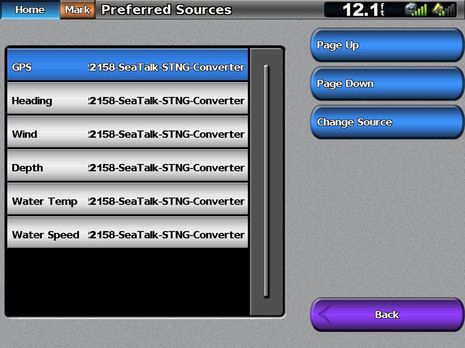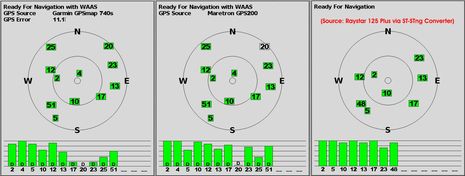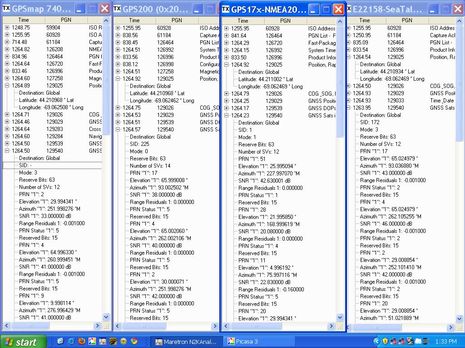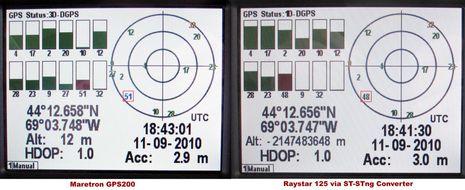Raymarine ST-STng converter, hand's on #1 (GPS)

What this screen means: Since Gizmo's current NMEA 2000 network has more than one sensor able to supply the types of data listed above, the Garmin 5212 gives me a choice of which source to use, and in each case I've chosen data that originated from Raymarine SeaTalk sensors and instrument displays, but was converted to SeaTalkNG (aka NMEA 2000) by Ray's much-discussed-on-Panbo ST-to-STng Converter. Not only does the Garmin perceive all that converted SeaTalk data as valid NMEA 2000 PGNs, but it all looks decent when displayed, and I've done similarly successful testing on the Simrad NSE, Lowrance HDS, and Furuno NN3D MFD. So, despite Ray's caution against using the converter on a standard N2K backbone, a whole passel of ST40 instruments are feeding Gizmo's network, and getting power off it. And maybe that's all you need to know, though I did get into some nitty gritty detail...
First off, it's ironic that doing similar testing on a Raymarine E-Wide is hard, because Ray has not yet developed facilities for listing the data sources on an attached STng or N2K backbone, let alone for choosing among them. However, the E Wide will use the first depth, or wind, or whatever PGN it sees, and if that sensor fails eventually (or is unplugged), it will automatically switch over to another one. Which is good enough for most installs and users.But I did see what may be minor glitches in the ST-STng data conversion, and today I'll cover GPS, which is one of the hardest data types to translate as there are so many values, PGNs, and diagnostic oddities involved, as you'll see. Below are three Garmin GPS status screens generated by selecting different sources on the screen at top. At left is what the 5212 sees coming in from a Garmin 740S (with internal GPS) that was running on the backbone, and, no surprise, all the subtle values like source name, Error distance, and Differential correction status per satellite are shown. The middle screen showing Maretron's latest GPS200 -- which I just got in for testing, and which is proving itself to be very able -- has all the details except the Error value, and finally the Raystar 125 Plus coming in via the ST-STng converter lacks a source name, error value, or any indication of WAAS Differential corrections. But don't jump to conclusions...
 The Raystar 125 claims to be a WAAS GPS, and I don't doubt it. I think the lack of "D" notations on that screen is most likely a data converter problem, while the lack of an error value is probably a Garmin peculiarity. I say that because I puzzled over N2KView screens showing the exact PGNs being sent by those three GPS sensors (plus a Garmin 17x), and I also checked out how the PGNs displayed on other GPS status screens. In the screen below, for instance, you can see certain real time PGNs from all four GPS sensors. A significant difference, it turns out, is that the native N2K sensors are showing a "PRN Status" of 5 for many of the satellites listed in the long 129540 "Satellites in View" PGN, while the Raystar lists all as 2. Consulting the Maretron GPS200 manual -- which, per usual, details PGN fields -- I learned that 5 means "Used with Differential Corrections" while 2 means "Used in solution without Differential corrections." So the Raystar/Converter is saying no WAAS, but does it mean it?...
The Raystar 125 claims to be a WAAS GPS, and I don't doubt it. I think the lack of "D" notations on that screen is most likely a data converter problem, while the lack of an error value is probably a Garmin peculiarity. I say that because I puzzled over N2KView screens showing the exact PGNs being sent by those three GPS sensors (plus a Garmin 17x), and I also checked out how the PGNs displayed on other GPS status screens. In the screen below, for instance, you can see certain real time PGNs from all four GPS sensors. A significant difference, it turns out, is that the native N2K sensors are showing a "PRN Status" of 5 for many of the satellites listed in the long 129540 "Satellites in View" PGN, while the Raystar lists all as 2. Consulting the Maretron GPS200 manual -- which, per usual, details PGN fields -- I learned that 5 means "Used with Differential Corrections" while 2 means "Used in solution without Differential corrections." So the Raystar/Converter is saying no WAAS, but does it mean it?... Well, below is a Maretron DSM250's status interpretation of the GPS200 and the Raystar. Note that both are labeled DGPS (though one is "3D" and the other an inexplicable "1D"). Note too the differential satellites 51 and 48 in red, and the very similar HDOP (Horizontal Dilution of Position) and Acc(uracy) figures. It sure looks to me like the Raystar is outputing a WAAS corrected position, even if it has the individual satellite codes wrong, even if it's somehow confusing WAAS sats 48 and 51, and even if Garmin goes its own way in terms of position accuracy. But do check out the Raystar's Altitude value, which puts Gizmo somewhere near the earth's core! That same value is in the Raystar PGN, and it's consistent every time I fire the unit up, so that's a genuine glitch either in the Raystar or more likely the converter. However, most boaters don't worry about altitude, and most displays won't even show it. So what to conclude?...
Well, below is a Maretron DSM250's status interpretation of the GPS200 and the Raystar. Note that both are labeled DGPS (though one is "3D" and the other an inexplicable "1D"). Note too the differential satellites 51 and 48 in red, and the very similar HDOP (Horizontal Dilution of Position) and Acc(uracy) figures. It sure looks to me like the Raystar is outputing a WAAS corrected position, even if it has the individual satellite codes wrong, even if it's somehow confusing WAAS sats 48 and 51, and even if Garmin goes its own way in terms of position accuracy. But do check out the Raystar's Altitude value, which puts Gizmo somewhere near the earth's core! That same value is in the Raystar PGN, and it's consistent every time I fire the unit up, so that's a genuine glitch either in the Raystar or more likely the converter. However, most boaters don't worry about altitude, and most displays won't even show it. So what to conclude?...  I'd choose a native NMEA 2000 GPS over a Raystar, simply because data conversion adds another layer of possible glitches, however inconsequential. But I wouldn't worry a bit about going to sea with the Raystar and converter as the primary GPS on an N2K system. I'd like to have a backup, of course, but the accuracy shown by all these GPS sensors is more than adequate, even though none were mounted on deck with a completely open sky view. More important, really, is how well the rest of the Seatalk sensors worked with N2K via the Converter, because that means many boaters with existing Seatalk gear can start building 2000 systems without having to replace their sensors and instrument displays. More on ST-STng wind, depth, and heading soon.
I'd choose a native NMEA 2000 GPS over a Raystar, simply because data conversion adds another layer of possible glitches, however inconsequential. But I wouldn't worry a bit about going to sea with the Raystar and converter as the primary GPS on an N2K system. I'd like to have a backup, of course, but the accuracy shown by all these GPS sensors is more than adequate, even though none were mounted on deck with a completely open sky view. More important, really, is how well the rest of the Seatalk sensors worked with N2K via the Converter, because that means many boaters with existing Seatalk gear can start building 2000 systems without having to replace their sensors and instrument displays. More on ST-STng wind, depth, and heading soon.

 Share
Share
By the way, I've tried several ways of installing the ST-STng Converter and they've all worked. But the setup behind all the screens above is probably the most extreme. The wind, depth/speed/temp, and heading sensors are all wired to their respective ST40 instrument displays, whose SeaTalk cables go to a couple of ST triple joiners and then to an ST-STng Converter. Which is daisy chained to another converter which handles the Raystar GPS and which finally patches to the NMEA backbone. In other words, all the SeaTalk gear, data and power feed, is on one drop.
What didn't work very well at all was using an ST70 to bridge any of the ST40 data onto the backbone, even though it has the latest software. The data displayed on the ST70 OK, but it rarely made it anywhere else in the system.